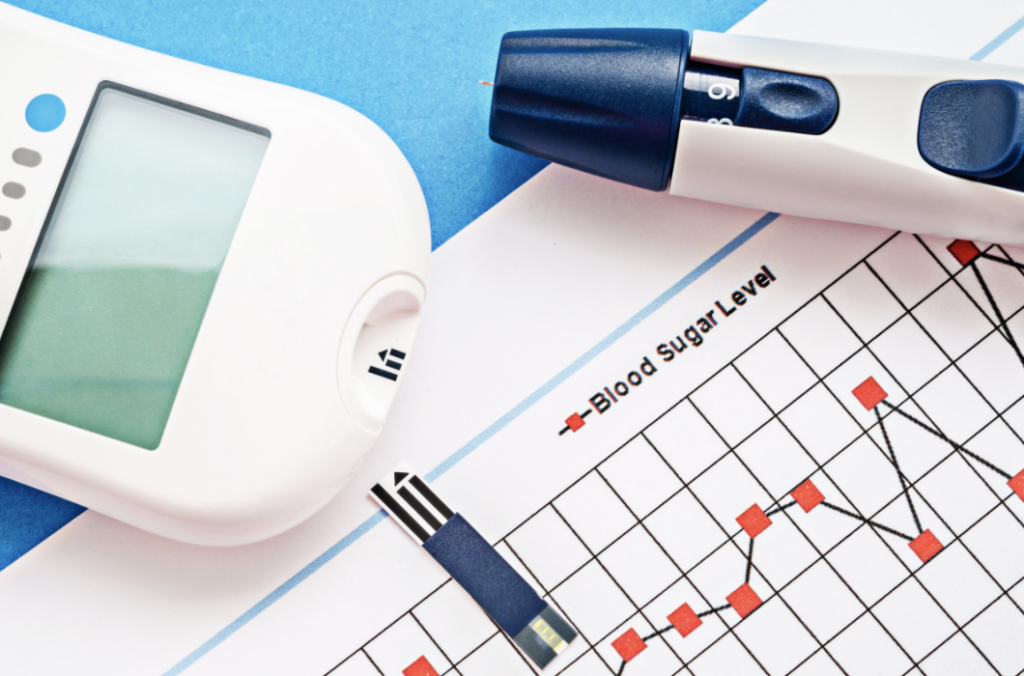
Written by Astrid Naranjo (Clean Health Accredited Clinical Dietitian)
Blood sugar management is important for health and body composition, more in the long term that it is short term or acutely, however, some clients may be more susceptible than others to perceive and be affected by acute blood sugar fluctuations (mood, energy, cognitive function, etc). Long term nutritional management of blood glucose dysregulation seems to be strategically correlated to the prevention of chronic diseases associated to insulin resistance and diabetes type 2 (1).
There is mechanistic evidence to suggest that elevated blood glucose levels contribute toward development of type 2 diabetes mellitus (T2DM) (2). Moreover, high blood glucose levels, including values that are below the cut-off for the diagnosis of diabetes, have been shown to be associated with an increased risk of cardiovascular events (1).
These days everyone has become so heavily focused on energy balance that many fitness professionals are just sending their clients to My Fitness Pal allowing them to eat whenever and whatever they like as long as it fits within their daily macros target.
This is a cop out by the trainer for two reasons. Firstly, it can cause decision fatigue, which can lead clients to making poor food choices and being less adherent to their diet. Secondly, it can cause blood sugar highs and lows which can create a host of problems in the body.
Before we dive deeper into this important topic, if you would like to learn more about our coaching tools and strategies for you to optimize not only your clients’ physique, but their mental fitness, overall wellness and quality of life, click here to enrol into the Performance Nutrition Coach Certification Collection!
Long periods without eating or overconsuming high glycaemic foods can cause blood sugar levels to drop rapidly and trigger a stress response by the body, which may cause norepinephrine and epinephrine to flood our bloodstream. While these stress chemicals are required to mobilize energy and fuel, they are a double-edged sword, and chronically elevated levels can be problematic (1-3).
Chronic stress and unable to manage this on a daily basis can also impact blood sugar levels not just daily, but also overtime. It is well known that acute stress elevates catecholamines that may cause additional effects such as sweating, rapid heartbeat, increased body temperature, anxiety, tremors, nausea, heart palpitations, and hunger, which are all symptoms commonly associated with hypoglycaemia (3,4).
In addition, poor glycaemic control, including both high and low blood glucose, has been associated with negative mood states such as anger, anxiety, and depression, and impaired cognitive performance (4-6). That would make it much more difficult for someone that’s not managing their blood sugar levels properly to adhere to their diet plan.
In fact, studies have shown those with insulin resistance are 50-80% more likely to overeat following a moderate or high glycaemic meal compared with a low glycaemic meal and have better adherence to a low carbohydrate diet (7,8). That could also be related to insulin resistance of the brain, which can blunt the satiety signal from insulin (8,9).

That is why it is important to have an understanding and appreciation of why managing blood sugar is so crucial, especially in those with insulin resistance, which makes up a significant portion of the population. A study from 2012 reported about 50% of all US adults have problems with blood sugar management (pre-diabetics and diabetics) (9,10). The prevalence of diabetes across other nations around the globe is equal to or even greater than in the United States, especially in the Western Pacific, Middle East, and North Africa (10,11).
This is why it’s not enough to just give your clients a daily macro goal and send them off to My Fitness Pal and hope that they will hit their daily targets. For the majority of your clients you will need to either teach them or give them an agreed/discussed nutrition plan with suggestions of what foods, how much and how often to eat while staying within their calorie and macro targets. This will help with adherence to their meal plan and promote better blood sugar management (especially if they are beginners or they truly struggle with an initial set up of their choices on their own).
Here are 5 basic recommendations for helping manage blood sugar levels:
1. Exercise Regularly and resistance train
Exercise has a significant impact on blood glucose management. That’s because exercise increases both insulin-independent and insulin dependent muscle glucose uptake (12). A combination of aerobic and resistance training may be more effective for blood glucose management than either type of exercise alone (12).
There is evidence to suggest that resistance training produced a more significant reduction in HbA1c level as compared to cardiovascular exercise. Hence, an optimal exercise program for individuals (especially those with insulin resistance/diabetes) should include a resistance training component to be effective in improving the overall metabolic profile, and thus reduce the risk for long term diabetic complications in type 2 diabetes (29).
Those with insulin resistance or metabolic syndrome should perform at least 150 minutes of moderate to vigorous aerobic exercise spread over a minimum of 3 days per week, with no more than 2 consecutive days in between bouts. Additionally, they should also perform resistance training at least 2-3 days per week (12).
2. Control Carbohydrate Intake
Several recent systematic reviews and meta-analysis have showed that controlling carbohydrate intake is effective for improving glycaemic control (13-15).
Controlling carbohydrates doesn’t mean eliminating carbohydrates altogether or following a very low carbohydrate diet. At this point there is not enough evidence to conclude which type of diet is optimal for glycaemic control, and it may vary from person to person. Studies have shown that low carbohydrate diets, low GI diets, the Mediterranean diet, and high-protein diets, are all effective for improving glycaemic control (15).
That’s because when we add protein, fat, or fibre to a meal, it slows down the rate of entry of glucose into the bloodstream which helps maintain more stable blood sugar levels. What we want to avoid is overconsuming too many high glycaemic, low fibre carbohydrates in one sitting, to prevent the blood sugar highs and lows.
A recent meta-analysis showed that habitual consumption of sugar sweetened beverages was associated with a greater incidence of type 2 diabetes, even when adjusted for adiposity (16). Assuming there was causality, consuming sugar sweetened beverages over many years may be related to a substantial increase in the onset of diabetes.
3. Increase Fiber Intake
As mentioned previously, fibre slows the digestion of carbohydrates and the rate of entry of glucose into the bloodstream. Several recent meta-analysis and systematic reviews have shown that increasing fibre intake improves glycaemic control (17,18). The recommended daily fibre intake of is about 14 grams for every 1,000 calories consumed (18).

4. Eat at Regular Times
At this point the optimal meal frequency for improving glycaemic control has not been well established or agreed upon. Most intervention studies have found conflicting results defining whether more meals are better (19,20).
When it comes to health and blood sugar management, several studies have shown that eating smaller more frequent meals could be associated with improved glycaemic control, lower hunger and greater satiety (21-22).But at the end of the day this is very individual. Some benefit and find better response from a more frequent meal pattern, others don’t.
As a dietitian, and from experience with many patients and clients, maintaining a regular eating schedule (regardless of the frequency) by avoiding snacking and skipping meals, may be more important than the meal frequency for keeping stable ghrelin and insulin levels throughout the day.
Ideally breakfast should be consumed within two hours of waking up, lunch should be consumed before 1pm, and dinner should be consumed no later than 2hrs before bedtime. Some people may do better having their breakfast and dinner a bit later. However, I still recommend having breakfast within 2hrs of waking up, lunch before 3pm, and dinner no later than 2hrs before bedtime (23). One study showed that ideally up to 50% of the total daily calories should be consumed at least 8hrs before the onset of melatonin, to optimize the circadian timing of food intake (24).
Lastly, several studies have shown that consuming a low carbohydrate or low GI breakfast can improve glucose tolerance at subsequent meals (25-27).
5. Ensure Adequate Micronutrient Intake
Several micronutrient deficiencies have been linked to hyperglycaemia and carbohydrate intolerance. Most notably that includes potassium, magnesium, chromium, calcium, vitamin C, vitamin D, and zinc (28).
Outside of taking a multivitamin supplement and consuming a balanced diet including a minimum of 5 servings of fruits and vegetable a day, I do not recommend taking therapeutic doses of any micronutrient unless you have specifically identified though blood work that your client has a deficiency, or that they are not getting an adequate amount from their diet.

In summary, blood sugar management is important for health and body composition, more in the long term that it is short term or acutely, however , some may be more susceptible than others to perceive and be affected by acute blood sugar fluctuations (mood, energy, cognitive function, etc). Long term nutritional management of blood glucose dysregulation seems to be strategically correlated to the prevention of chronic diseases associated to insulin resistance and diabetes type 2.
References
- Russell WR, et al. Impact of Diet Composition on Blood Glucose Regulation. Crit Rev Food Sci Nutr. 2016;56(4):541-90. doi: 10.1080/10408398.2013.792772. PMID: 24219323.
- Blaak, E. E., Antoine, J., et al. (2012) Impact of postprandial glycaemia on health and prevention of disease. Obes. Rev. 13(10):923–984.
- Guyton AC, Hall JE. Textbook of Medical Physiology (11th ed.). Philadelphia, PA: Elsevier (2006) p.971
- Flint A, et al. Associations between postprandial insulin and blood glucose responses, appetite sensations and energy intake in normal weight and overweight individuals: a meta-analysis of test meal studies. British Journal of Nutrition. 2007 Jul;98(1):17-25.
- Penckofer S, Quinn L, Byrn M, Ferrans C, Miller M, Strange P. Does glycemic variability impact mood and quality of life?. Diabetes Technol Ther. 2012;14(4):303–310. doi:10.1089/dia.2011.0191
- Sommerfield AJ, Deary IJ, Frier BM. Acute Hyperglycemia Alters Mood State and Impairs Cognitive Performance in People With Type 2 Diabetes. Diabetes Care Oct 2004, 27 (10) 2335-2340; DOI: 10.2337/diacare.27.10.2335
- Ludwig DS, Majzoub JA, Al-Zahrani A, Dallal GE, Blanco I, Roberts SB. High glycemic index foods, overeating, and obesity. Pediatrics. 1999;103(3), e26-e26.
- McClain A, et al. Adherence to a low‐fat vs. low‐carbohydrate diet differs by insulin resistance status. Diabetes, Obesity and Metabolism. 2013;15(1), 87-90.
- Menke A, Casagrande S, Geiss L, Cowie CC.Prevalence of and Trends in Diabetes Among Adults in the United States,1988-2012. JAMA. 2015;314(10):1021–1029. doi:https://doi.org/10.1001/jama.2015.10029
- Kharroubi AT, Darwish HM. Diabetes mellitus: The epidemic of the century. World J Diabetes. 2015;6(6):850–867. doi:10.4239/wjd.v6.i6.850
- Colberg SR, Sigal RJ, Fernhall B, et al. Exercise and type 2 diabetes: the American College of Sports Medicine and the American Diabetes Association: joint position statement. Diabetes Care. 2010;33(12):e147–e167. doi:10.2337/dc10-9990
- Hall KD, Chung ST. Low-carbohydrate diets for the treatment of obesity and type 2 diabetes. Curr Opin Clin Nutr Metab Care. 2018 Jul;21(4):308-312. doi: 10.1097/MCO.0000000000000470.
- Ojo O, Ojo OO, Adebowale F, Wang XH. The Effect of Dietary Glycaemic Index on Glycaemia in Patients with Type 2 Diabetes: A Systematic Review and Meta-Analysis of Randomized Controlled Trials. Nutrients. 2018;10(3):373. Published 2018 Mar 19. doi:10.3390/nu10030373
- Ajala O, English P, Pinkney J. Systematic review and meta-analysis of different dietary approaches to the management of type 2 diabetes. Am J Clin Nutr. 2013 Mar;97(3):505-16. doi: 10.3945/ajcn.112.042457. Epub 2013 Jan 30.
- Imamura F, O’Connor L, Ye Z1, Mursu J, Hayashino Y, Bhupathiraju SN4, Forouhi NG. Consumption of sugar sweetened beverages, artificially sweetened beverages, and fruit juice and incidence of type 2 diabetes: systematic review, meta-analysis, and estimation of population attributable fraction. Br J Sports Med. 2016 Apr;50(8):496-504. doi: 10.1136/bjsports-2016-h3576rep.
- Silva FM, Kramer CK, de Almeida JC, Steemburgo T, Gross JL, Azevedo MJ. Fiber intake and glycemic control in patients with type 2 diabetes mellitus: a systematic review with meta-analysis of randomized controlled trials. Nutr Rev. 2013 Dec;71(12):790-801.
- McRae MP. Dietary Fiber Intake and Type 2 Diabetes Mellitus: An Umbrella Review of Meta-analyses. J Chiropr Med. 2018;17(1):44–53. doi:10.1016/j.jcm.2017.11.002
- Timm, D. A., & Slavin, J. L. (2008). Dietary Fiber and the Relationship to Chronic Diseases. American Journal of Lifestyle Medicine, 2(3), 233–240. https://doi.org/10.1177/1559827608314149
- St-Onge MP, et al. Meal Timing and Frequency: Implications for Cardiovascular Disease Prevention: A Scientific Statement From the American Heart Association. Circulation. 2017 Feb 28;135(9):e96-e121. doi: 10.1161/CIR.0000000000000476. Epub 2017
- Paoli A, Tinsley G, Bianco A, Moro T. The Influence of Meal Frequency and Timing on Health in Humans: The Role of Fasting. Nutrients. 2019 Mar 28;11(4). pii: E719. doi: 10.3390/nu11040719.
- Farshchi HR, Taylor MA, Macdonald IA. Regular meal frequency creates more appropriate insulin sensitivity and lipid profiles compared with irregular meal frequency in healthy lean women. Eur J Clin Nutr. 2004 Jul;58(7):1071-7.
- Alhussain MH, Macdonald IA, Taylor MA. Irregular meal-pattern effects on energy expenditure, metabolism, and appetite regulation: a randomized controlled trial in healthy normal-weight women. Am J Clin Nutr. 2016 Jul;104(1):21-32. doi: 10.3945/ajcn.115.125401. Epub 2016 Jun 15.
- Lopez-Minguez J, Gómez-Abellán P, Garaulet M. Timing of Breakfast, Lunch, and Dinner. Effects on Obesity and Metabolic Risk. Nutrients. 2019;11(11):2624. Published 2019 Nov 1. doi:10.3390/nu11112624
- McHill AW, Phillips AJ, Czeisler CA, et al. Later circadian timing of food intake is associated with increased body fat. Am J Clin Nutr. 2017;106(5):1213–1219. doi:10.3945/ajcn.117.161588
- Clark CA, Gardiner J, McBurney MI, Anderson S, Weatherspoon LJ, Henry DN, Hord NG. Effects of breakfast meal composition on second meal metabolic responses in adults with Type 2 diabetes mellitus. Eur J Clin Nutr. 2006 Sep;60(9):1122-9. Epub 2006 May 3.
- Nilsson AC, Ostman EM, Granfeldt Y, Björck IM. Effect of cereal test breakfasts differing in glycemic index and content of indigestible carbohydrates on day long glucose tolerance in healthy subjects. Am J Clin Nutr. 2008 Mar;87(3):645-54.
- Chang CR, Francois ME, Little JP. Restricting carbohydrates at breakfast is sufficient to reduce 24-hour exposure to postprandial hyperglycemia and improve glycemic variability. Am J Clin Nutr. 2019 May 1;109(5):1302-1309. doi: 10.1093/ajcn/nqy261.
- Chehade J, Sheikh-Ali M, Mooradian A. The Role of Micronutrients in Managing Diabetes. Diabetes Spectrum. 2009;22. 214-218. 10.2337/diaspect.22.4.214.
- Bweir, S., Al-Jarrah, M., Almalty, AM. et al. Resistance exercise training lowers HbA1c more than aerobic training in adults with type 2 diabetes. Diabetol Metab Syndr 1, 27 (2009). https://doi.org/10.1186/1758-5996-1-27






